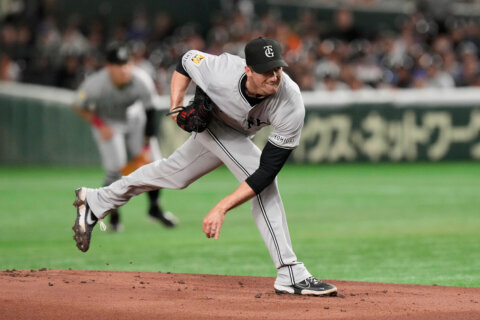WASHINGTON — It was only a matter of time.
Even for those who have fought the notion for years, the truth has become inescapable. At just 22, Bryce Harper is the best player on the Washington Nationals.
Ever since the entirely unrealistic expectations were levied upon him by Tom Verducci and the editors at Sports Illustrated nearly six full years ago, Harper has been chasing a mirage, an unattainable, perfect version of himself. He has been disparaged on a national stage through comparisons to Mike Trout, another exceedingly rare talent, who happened to come along and mature immediately ahead of him on the development curve.
And while it’s still quite early in the 2015 campaign, Harper leads Trout in home runs, on-base percentage, slugging percentage, extra-base hits and RBI. He leads the National League in both walks (27, tied) and home runs (11), the two positive true outcomes.
If the entire 2015 season is primed to be his coming out party, this week was the prelude. His three-homer, five-RBI Wednesday single-handedly powered the Nats past the Marlins to win a crucial intradivision home series. He then opened the Atlanta series with an encore five-RBI performance, adding two more home runs in a runaway win. Harper capped the weekend with two more multi-hit games, finishing the series 7-for-12 with a walk, a double, three home runs, five runs scored and eight RBI, keying the club’s first three-game home sweep of the Braves since 2008.
And that’s the most important part — for a team on which no other player has been particularly impressive offensively, Harper has been a standalone star. He owns at least a share of the team lead in nearly every offensive category, and has as many home runs as the next four power leaders on the team combined. And while circumstances are often out of a player’s hands, eight of his 11 homers have either tied the game of given Washington the lead.
For those who assume that Harper should hit 30 or more each year, consider the following numbers:
- 11: The number of major leaguers to hit 30+ home runs in 2014
- 1: The number of major leaguers to hit 30+ home runs each of the past two seasons
That’s right, only one big leaguer has hit 30 or more two years running, and you probably didn’t think it was Edwin Encarnacion (36, 34). That’s how rare it is to have a player with that type of power in today’s game.
Furthermore, it should be silly for any Nationals fan to expect that level of power production. Care to wager how many 30-home run campaigns Jayson Werth or Ryan Zimmerman have in their careers? The answer is one apiece, each accomplished all the way back in 2009, when Werth was still in Philadelphia. His high in a Washington uniform was 25, two years ago.
How is Harper doing it? He’s swinging at fewer pitches outside the strike zone than ever has before, and hitting at a better contact rate on pitches in the zone, nearly 90 percent. Of course, right now over 35 percent of the balls he’s hitting in the air are leaving the ballpark. That rate won’t continue at anywhere close to that mark (his career average is roughly half that rate).
But Harper is on pace to hit 56 home runs this season. Even if he slows dramatically, to just over half that rate, he’ll collect his first 30-dinger campaign, the first by any National since Adam LaRoche in 2012. Meanwhile, his .433 on-base percentage is nearly 90 points above his career average prior to this season, and even more impressive considering his power surge.
We saw the beginning of this breakout in the 2014 NLDS, when Harper smashed three home runs in just 19 plate appearances, establishing himself clearly as the biggest threat in Washington’s lineup. But he has showed the baseball world that his eye-catching October was no fluke, merely a harbinger of the season to come.







